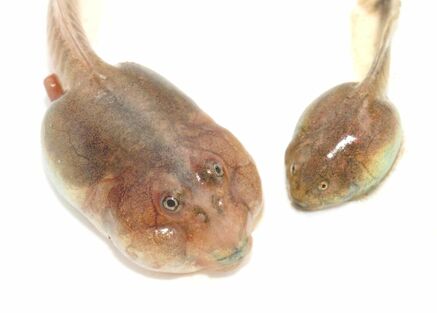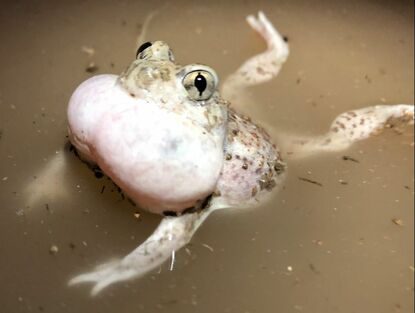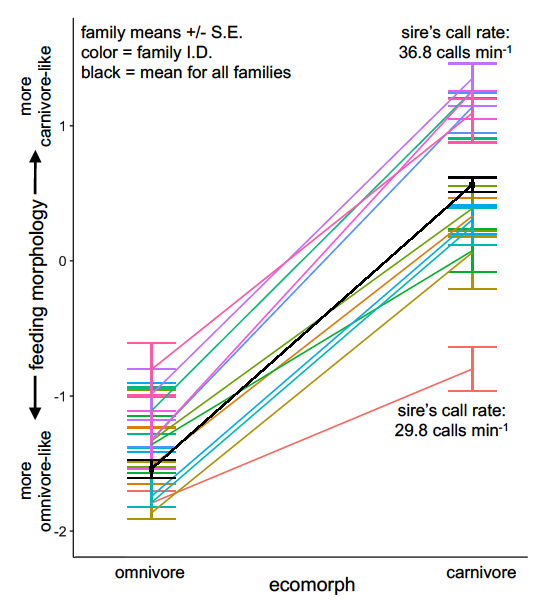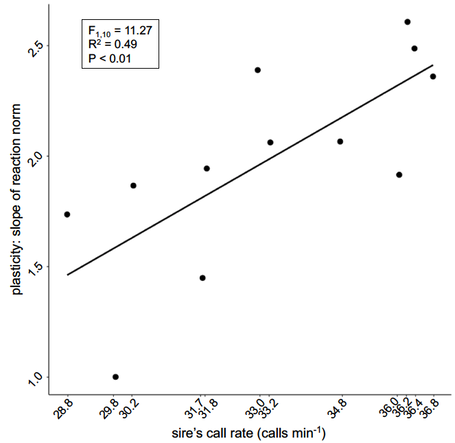Mate choice and the evolution of phenotypic plasticity
Left image courtesy of David Pfennig
Phenotypic plasticity can facilitate adaptive responses to fluctuating environmental conditions. Whether adaptive plasticity will evolve depends on a number of factors, including the salience and reliability of environmental cues, the pace of environmental fluctuations, and the amount of genetic and phenotypic variation among members of a population. My PhD research (co-advised by David and Karin Pfennig, UNC) revealed a novel potential influence on the evolution of adaptive plasticity. We demonstrated that the degree and likelihood of the expression of adaptive plasticity in spadefoot toad (Spea multiplicata) tadpole resource-use morphology is strongly correlated with an adult sexual trait: call rate (see figures below). Because female spadefoot toads preferentially mate with fast-calling males, and because fast-calling males sire tadpoles that are best-able to express adaptive plasticity, sexual selection by female mate choice likely plays an important role in the maintenance - and may have facilitated the origin - of adaptive plasticity in tadpole resource-use morphology. To my knowledge, this is the first example of offspring plasticity functioning as an indirect benefit of mate choice. Read all about it in our paper that appears in a special issue of Phil. Trans. B.
We are currently investigating the implications of our findings in the following contexts:
We are currently investigating the implications of our findings in the following contexts:
- The interaction of reproductive and ecological character displacement: Owing to negative reproductive interactions with a congener, Spea bombifrons, in some populations of S. multiplicata, female S. multiplicata no longer express preferences for fast-calling males. In addition, S. multiplicata tadpoles express greatly reduced plasticity in these populations as a result of competition with S. bombifrons tadpoles. These dynamics may reflect reproductive and ecological character displacement, respectively. An intriguing implication of the association of call rate with tadpole plasticity is that divergence in female preferences may have contributed to the reduction in tadpole plasticity, such that one form of character displacement was facilitating the other as they unfolded. We are investigating this possibility by performing competition experiments using allopatric S. multiplicata and sympatric S. bombifrons tadpoles sired by males of known call rates.
- S. multiplicata ecology varies in more ways than the presence or absence of S. bombifrons. The ponds in which S. multiplicata tadpoles develop vary in size and longevity, and this variation is driven for the most part by dramatic annual variation in summer rainfall. These fluctuating pond characteristics contribute, in turn, to the availability of different forms of dietary resources, which is one of the primary environmental cues that drive the expression of adaptive plasticity among S. multiplicata tadpoles. This suggests that female mate-choice preferences may vary with pond characteristics, which should determine the value of the indirect benefits of mate choice. We are investigating this possibility by characterizing female preferences and tadpole plasticity among S. multiplicata populations with consistent differences in pond variability.



